Fujifilm X-Pro2 Review
Fujifilm X-Pro2 Introduction
The Fuji X-Pro2 is the follow up to the original Fuji mirrorless. This new model packs a higher-resolution 24 megapixels X-Trans CMOS III sensor with a 1.5X crop-factor and 3:2 aspect-ration in a similar retro-style body which is now weather-sealed. This sensor forgoes an anti-alias filter thanks to its unique color-filter-array which is not prone to Moire artifacts.
A revised hybrid shutter allows this mirrorless to offer shutter-speeds from 1/32000s to 30s, plus bulb exposures of up to an hour. It can sustain a full 8 FPS at full-resolution with a deep buffer for 83 JPEG images or 33 RAW files. The new 24 MP sensor offers a wide sensitivity range, covering ISO 200-12800, which is expandable to 100-51200.
The X-Pro2 features a hybrid viewfinder which switches between a 2.4 megapixels 0.48" EVF and a rangefinder-style OVF mode. It also features a rear 3" LCD with a class-leading 1.6 megapixels of resolution to provide another sharp and precise way of composing and reviewing images or video. An Eye-Start sensor automatically switches between the viewfinder and rear LCD as needed. The XF lens mount on this camera is fully compatible with all previously introduced Fuji mirrorless lenses.
As one can easily guess from its name, the X-Pro2 is targeted at professional photographers with numerous direct controls, including dual control-dials plus a dial to control both ISO and Shutter-Speed, a direct EC dial and a focus-point joystick in addition to the aperture-ring present on most Fuji lenses. There is an standard hot-shoe, sync-port, threaded-release and built-in WiFi for connectivity.
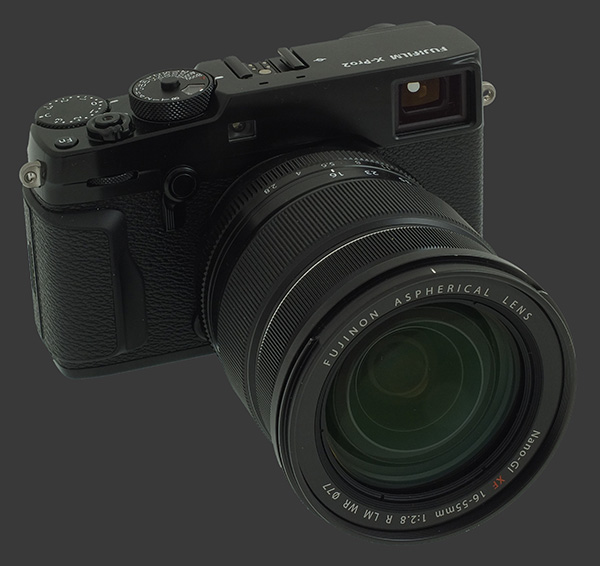
This digital camera review analyses the usability, performance and image quality of the Fuji X-Pro2.
Fuji X-Pro2 Features
Sensor
- 24 Megapixels CMOS sensor
- X-Trans 6x6 Color-filter array
- No Anti-Alias filter
- 1.5X Crop factor (APS-C)
- 3:2 Aspect ratio
- Fuji XF lens mount
- Built-in Dust-Reduction
Exposure
- ISO 200 to 12800 sensitivity range, 1/3 EV steps
- ISO 100, 25600 and 51200 expansion, Mechanical Shutter Only
- Auto ISO, Selectable maximum from 400 to 12800
- 1/8000-30s Mechanical Shutter, 1/3 EV steps
- 1/32000-1s Electronic Shutter, 1/3 EV steps
- Bulb exposure, maximum 1 hour
- PASM Exposure modes
- Metering: Multi-Segment, Center-Weighed, Spot and Average
- Exposure-Compensation: ±5, 1/3 EV increments
- Automatic and selectable Dynamic-Range, 100%, 200% or 400%
- Forced, Slow-Sync, Rear-Sync, Off and Commander flash modes
- Flash-Compensation: ±2, 1/3 EV increments
Image Parameters
- Automatic, 7 presetsSunny, Shade, 3 Fluorescents, Incandescent, Underwater, Kelvin and Custom WB
- WB Fine-Tuning: 19 steps along 2 axis
- WB Bracketing: 3 frames, 3 step sizes
- Film Simulation: Provia, Velvia, Astia, Classic-Chrome, Pro Negative Hi, Pro Negative Standard, 2 B&W styles and Sepia
- Film Simulation Bracketing, 3 frames
- Adjustable Color, Sharpness and Noise Reduction, 9 levels each
- Adjustable Highlight and Shadow tone, 7 levels each
- Optional Long-Shutter Noise Reduction
- Optional Lens Modulation Optimizer
- Optional Grain Effect, 2 levels
Focus
- Single-Shot, Continuous, DMF or Manual focus
- 273-Point Contrast-Detect AF system
- 169-Point Hybrid Phase-Detect AF system
- Point-Selection, 5 sizes
- Area-Selection, 3 sizes
- Optional Eye-Start Sensor Pre-AF
- Optional Face & Eye Priority AF
- Optional Electronic Magnification Focus-Assist
- Optional Focus-Peaking, 2 levels, 3 colors
- Optional Digital Split-Image
- Optional AF-Assist lamp
- Fly-By-Wire focus ring on most lenses
Drive
- 8 FPS Continuous Drive, 83 JPEG or 33 RAW
- 3 FPS Unlimited Continuous Drive
- ISO Bracketing: 3 frames, ±1 EV steps
- Auto-Exposure Bracketing: 3 frames, ±2 EV steps
- Dynamic-Range Bracketing, 3 frames
- Multiple-Exposure, 2 frames
- Self-timer, 2s or 10s
Video
- 1920x1080 @ 60 FPS Video
- 1280x720 @ 60 FPS Video
- Stereo Microphone, 4 levels
- Quicktime H.264 Codec
Display & Viewfinder
- Hybrid EVF/OVF:
- 0.48" EVF, 2.4 Megapixels, 100% coverage
- 0.36 / 0.6X Dual-Magnification OVF, 92% coverage lines, Over 100% view
- Eye-Start Sensor
- 3" LCD, 1.6 Megapixels
- Digital Level, 1-axis
- Depth-Of-Field Preview
- Depth-Of-Field Scale, 2 levels
- Optional Live-Histogram
- Optional Framing-Guides, 3 types
Output Processing
- 24, 12 and 6 Megapixels modes
- 16:9 and 1:1 Cropped aspect-ratios
- JPEG, RAW, RAW+JPEG capture
- 2 JPEG Compression levels
- Uncompressed or Lossless Compressed RAW
Body
- Dual Control-Dials
- Customizable Function (Fn) button
- Aperture-Ring on most lenses
- Shutter-Speed dial, 1/8000-1s, 1 EV steps
- ISO dial, 100-25600/51200, 1/3 EV steps
- Exposure-Compensation dial, 1/3 EV steps
- Dedicated AE-L & AF-L buttons
- Focus-Point Joystick
- Standard Hot-Shoe
- Built-in WiFi
- HDMI (1080i) output
- USB 2.0 connectivity
- Dual SDXC memory
- Lithium-Ion battery
Fujifilm X-Pro2 Ergonomics - How easy is it to handle?
Fuji designed the X-Pro2 with a strong resemblance to a range-finder camera, giving it a retro look. This adds a sense familiarity and luxury while embracing more mechanical controls. Such controls predate menus and provide much more direct control over the camera. The retro design also has a boxy shape which is not as comfortable as modern camera with curves and angled surfaces.
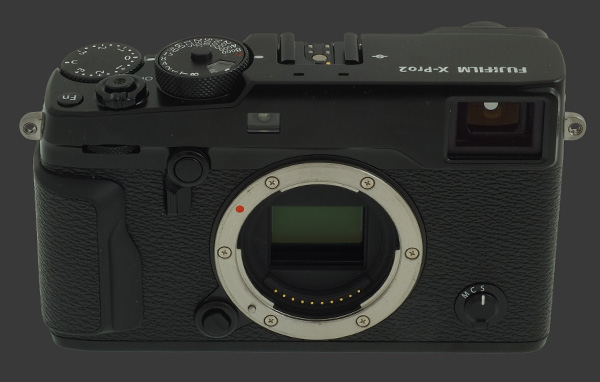
The front of the camera definitely looks anachronistic. There is a viewfinder window which opens up when the camera is off and in OVF mode. Opposite is a yellow AF-assist lamp. A bit below it, a spring-loaded lever which serves to switch the hybrid viewfinder between its electronic and optical mode. This one works well and is within easy reach of the forefinger when holding the camera. Since the EVF and OVF experience are so different, we suspect most photographers will simply use one or the other. The X-Pro2 adds a customizable button in the center of the viewfinder lever.
A 3-position switch at the base of the lens mount selects the focus drive. The positions are labelled for Single-Shot, Continuous and Manual. When AF+MF is set to ON in the AF/MF menu, Direct Manual Focus (DMF) is available at the S position. In M mode, the Fuji X-Pro2 offers a number of focus-assist mode: Standard which magnifies the preview around the focus-point, Digital Split Image which shows information from Phase-Detect sensors to simulate a traditional split-focus screen and Focus Peaking which highlights edges of maximum sharpness in one of three colors with a choice of two contrast levels.
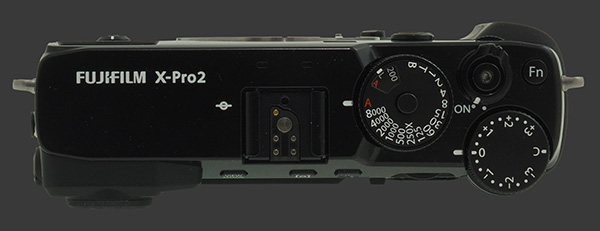
The top of the X-Pro2 is also clearly retro. Only the Fn button here gives a hint of modernity. That button can be programed to activate one of 25 functions, including Depth-Of-Field Preview and Video-Record which are otherwise unaccessible. Its a tough call choosing what to put there. Unfortunately, the Fn button can no longer set ISO which now has its own dial embedded in the shutter-speed dial. More about it further down this review page.
To the left of the Fn button, there is a small two-stage shutter-release which is threaded for a mechanical remote-triggering cable. It is there probably just for nostalgia rather than practical reasons since the X-Pro2 has an electronic remote-release connector which also serves as stereo auxiliary input during video capture. It also offers built-in WiFi and the Fuji Camera Remote application obviously supports wireless shooting, even with a live preview. The shutter-release has a moderate amount of travel and a firm halfway point. Since this can inadvertently shake the camera, some third-party companies offer threaded soft-release buttons.
There is an Exposure-Compensation dial, marked from +2 to -3 in 1/3 stops. The dial is easily accessible with the camera at eye-level but has somewhat soft detents. There is a new C position on the dial which allows the photographer to control EC from -5 to +5 after pressing on the front control-dial. The dial must be pressed again to resume normal operation, so this makes for a modal and accident-prone interface. The retro-price paid here is that exposure increments are hard-wired to 1/3 EV.
The largest dial on the Fuji X-Pro2 controls Shutter-Speed and ISO. The top of the dial marks shutter-speeds from 1/8000 to 1s in full-stops. It has three extra positions:
- A - Indicates the camera should automatically choose shutter-speed.
- T - Allows the rear control-dial to set any allowable exposure time.
- B - Activates Bulb mode which allows up to one hour exposures when the lens aperture ring is set away from the A position. Otherwise, it exposes for 30s.
To prevent accidentally changing from P or A mode to S or M, respectively, the shutter-speed dial locks itself in the A position. Outside of the A position, it stays unlocked yet with soft detents. The rear control-dial must be used to select fractional shutter-speeds.
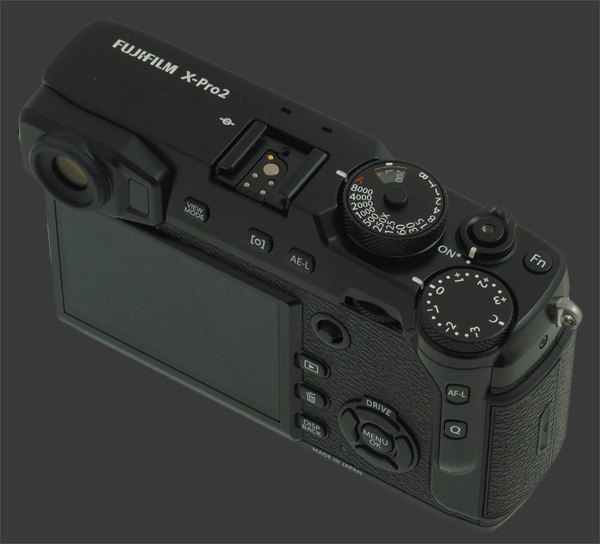
The major change compared to the X-Pro1 is the new ISO dial embedded within the shutter-speed dial. A transparent plastic window shows the currently selected ISO through the dial, in 1/3 EV stops from 200 to 12800. There is an L position for ISO 100 and an H position for either ISO 25600 or 51200, depending on a menu setting. This is a baffling choice since they could have squeezed in one more item or only included full stop increments which would have made changing ISO faster.
Changing ISO requires lifting a spring-loaded collar and rotating it. This is made even more uncomfortable than it sounds since there are stops for every 1/3 EV in the standard ISO range of the X-Pro2. This requires twisting the collar a significant amount while maintaining upwards force. Rotating the shutter-speed dial also necessarily moves the ISO window which means often reading settings at an odd angle. The top plate offers a standard hot-shoe for external lighting. There is also a focal-plane indicator mark which is surprisingly towards the middle of the body.
The back of the camera is where all the remaining action is. This side looks more modern, at least if we ignore the texture and round viewfinder window. The position of the viewfinder is ideal for comfort and avoids having to press your nose against the LCD. The round frame around it made of hard plastic which would benefit from a soft rubber coating. Right next to it is the Eye-Start Sensor that automatically enables the Hybrid viewfinder based on proximity. Once used to one of these, there is no going back! Its sensitivity is just right, although you can turn it off using the VIEW MODE button to its right.
The Hybrid Viewfinder is an superb technological achievement. With the push a lever, it switches between one of the best electronic viewfinders and the most sophisticated optical viewfinder ever made. In EVF mode, the viewfinder shows 100% coverage with a nice 0.59X magnification. It is incredibly sharp with 2.4 megapixels and refreshes at a speedy 85 Hz. While there are larger ones out there, it is comfortable and shows focus well.
The OVF mode is a Reverse Galilean viewfinder. Since it is not TTL, it always shows the same view regardless of focal-length. This unfortunately even includes a view of the lens which partially obstructs framing. A layer of liquid crystal allows Fuji to overlay an electronic bright frame which shows the 92% coverage area. It resizes itself with the zoom, sliding from 0.6X to 0.36X magnification. This makes the framing area rather small starting at medium focal-lengths. The X-Pro2 display a considerable amount of information over the OVF, including a focus-frame which shifts to account for parallax when focus is locked.
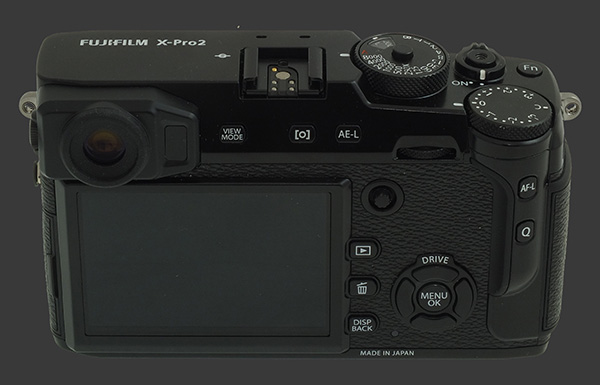
Right below the hot-shoe, there is a Metering button which brings up a menu of 4 icons, one for each metering mode: Multi-Segment, Center-Weight, Spot and Average. Next to its, the AE-L button locks exposure while being pressed. One can repurpose the Metering button, to the same 25 options as the Fn button. AE-L can be swapped with AF-L which is also on the back of the camera. Further right, there is a slim rear control-dial. It can be used to enable MF-Assist or change settings in the Quick Menu which is invoked by pressing the Q button located along the right edge of the camera, below AF-L which locks focus in AF mode and performs AF in MF mode. This is very useful and provides an easy way to focus once before a series of shots.
Similar to the previous Fuji flagship mirrorless, the X-T1 Graphite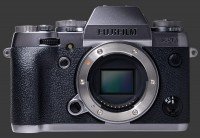
Fujifilm X-T1 Graphite, this digital camera offers both direct dials and dual control-dials. Counting that most XF-mount Fujinon lenses also have an aperture ring, there are direct dials for aperture, shutter-speed, ISO and EC, plus dual control-dials. Most professional cameras need fewer dials since there are only 3 exposure-parameters anyway. This issue is that the X-Pro2 has several incomplete controls: the shutter-speed dial only accesses full-stops between 1/8000 and 1s, the ISO dial is missing one expanded sensitivity and the EC dial is limited to ±3.
One can place the shutter-speed dial at T and use the rear control-dial to set the shutter-speed but the front control-dial remains modal when the EC dial is set to C. ISO must be set via the dedicated dial within the shutter-speed dial, so there is no choice but to use the menu system to switch between the two expanded High-ISO settings. The control-dials themselves are too flush with the camera body to use with gloves on. More crucially though, detents are too soft on all dials which causes frequent accidental changes to parameters.
There are several other controls on the back of this digital camera. Completely new to Fuji mirrorless cameras is a small 8-way joystick. It allows to quickly move the focus-area directly. The X-Pro2 offers either 273 focus-points, of which 169 are Hybrid Phase-Detect ones, or 77 of which 49 are hybrid. It can also focus on an area, taking a 3x3, 5x5 or 7x7 block out of the 77 available points. The joystick is slight sharp yet quite efficient to use.
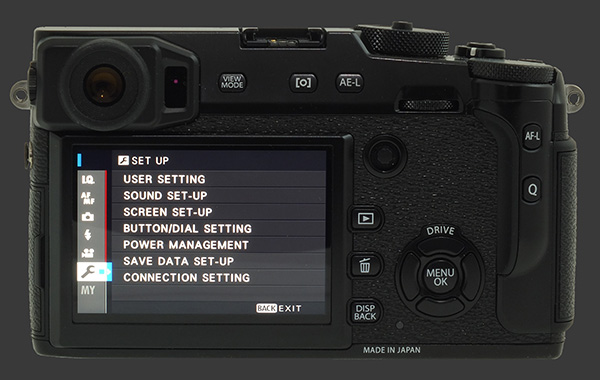
Along the right edge of the LCD, there is a Playback, Delete and Disp/Back button. Playback and Delete work just as usual. The latter does nothing in Capture mode. Disp cycles over 3 display modes: The usual preview with information overlay, image only preview and information only view. This last setting is unique and highly interesting since it provides a live-histogram of the scene. In that case, framing must obviously be done via the viewfinder. When in OVF mode, this can be done without delay.
There is a 4-way controller with central Menu/OK button made of 5 separate buttons. Up always controls Drive Mode with 9 options to choose from: Single-Shot, Continuous, AEB, ISO Bracketing, Film Simulation Bracketing, WB Bracketing, Dynamic-Range Bracketing, Multiple Exposure and Advanced Filter. The remaining 3 directions of the 4-way controller are individually customizable to the same 25 functions as the Fn button on the top plate. Note that there is no Video mode anywhere, so one button must be set to Video-Record to film. Had it been a Drive Mode, this would not be necessary.
The back of this Fuji includes a large 3" LCD with a class-leading resolution of 1.6 megapixels. The display is extremely sharp and bright with a good refresh rate. Visibility is good both indoors and outdoors. The display is unfortunately not always Exposure-Priority. This means that exposure is not shown consistently which requires reviewing images more often then necessary.
On the grip-side of the X-Pro2 there is a sturdy weather-sealed door which covers dual SDXC memory card slots. When two cards are present, the camera can use them in sequence, write the same to both or store JPEG images in one and RAW files in the other. On the opposite side of the camera, one finds a Sync-Port, plus a thin door covering a Micro USB, Micro HDMI and Micro-Jack for stereo input or a wired remote.
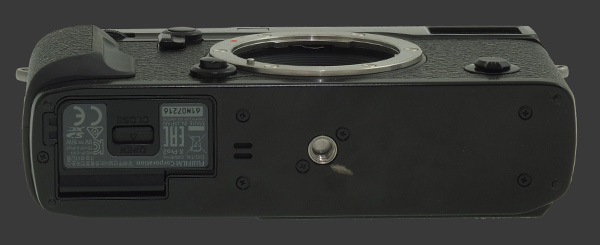
The bottom of the camera features a metal tripod-thread which is inline with the optical axis of the camera. There is also a battery-compartment door which is very solid. Like the memory-compartment door, this one has a rubber seal to make it weatherproof.
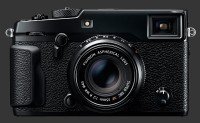 |
Please Support Neocamera
All information on Neocamera is provided free of charge yet running this website is a huge endeavor. Purchases made via affiliate links found throughout the site help keep it running and up-to-date. There is no additional cost to you, so please consider buying via these links to our affilates:
If you found any information on this site valuable and did not purchase via our affiliate links, please considering donating via PayPal:
Any amount will be greatly appreaciated. Thank you for your support!
Fujifilm X-Pro2 Highlights

Sensor-Size: 24 x 16mm

Actual size when viewed at 100 DPI
| 24 Megapixels Mirrorless | ISO 100-51200 |
| Fujifilm X Mount 1.5X FLM | Shutter 1/32000-30s |
| 0.48" Hybrid EVF 2.4 Megapixels (0.59X) | Full manual controls, including Manual Focus |
| Automatic Eye-Start sensor | Custom white-balance with 2 axis fine-tuning |
| 1 Axis Digital Level | Spot-Metering |
| Weatherproof down to -10C | Hot-Shoe & Sync-Port |
| Built-in Dust Reduction | Stereo audio input |
| 8 FPS Drive, 83 Images | Lithium-Ion Battery |
| 1920x1080 @ 60 FPS Video Recording | Secure Digital Extended Capacity x 2 |
| 3" LCD 1.6 Megapixels |
Updates
2024.11.18

Best 2024 Photography Gifts for Every Budget
Great gifts for photographers and photo enthusiasts selected for every budget among the best products of 2024.
2024.08.07

Eye Protection Tips for Professional Photographers
The four main considerations for professional photographers regarding eyewear.
2024.07.14

Fujifilm X100VI Review
Flagship fixed-lens compact digital camera with a 40 MP sensor and Image-Stabilization, a first for the series. Retro design featuring dual control-dials, plus direct ISO, Shutter-Speed and EC dials. Its hybrid viewfinder can switch between EVF and OVF mode.
2024.05.09

Fujifilm GFX100 II Review
Flagship 102 Megapixels Medium-Format Mirrorless Digital Camera with 8-Stop 5-Axis IBIS, 8 FPS Drive, 8K Video and 400 MP Super-Resolution capture in a weatherproof and freezeproof body with dual control-dials and dual memory-card slots.
2024.04.03

Fujifilm X-T5 Review
Newest Fujifilm flagship boasting a 40 MP APS-C sensor, 5-axis IBIS with 7-stop efficiency, 15 FPS continuous drive, 6.2K Video capture, dual control-dials and dual SDXC UHS-II slots in a sturdy weatherproof and freezeproof body.
2023.11.20

Best Digital Cameras of 2023
Find out which are the Best Digital Cameras of 2023. All the new Mirrorless Digital Cameras from entry-level to high-end professional.
2023.07.10

Fujifilm X-H2 Review
40 Megapixels APS-C Hybrid Mirrorless Digital Camera with 7-stop IBIS. Fastest shutter ever and 8K video capture. Large builtin EVF with 0.8X magnification and 5.8 MP, plus an Eye-Start Sensor. Packed with features and large number of controls in a weatherproof and freezeproof body.
2023.05.07

Sony FE 20-70mm F/4G Review
Review of the unique Sony FE 20-70mm F/4G lens. The optical zoom of this lens spans ultra-wide-angle and medium focal-length coverage, making it one of the most versatile Full-Frame lenses on the market.
2023.01.15

Huion Inspiroy Dial 2 Review
Review of the Huion Inspiroy Dial 2 tablet, a medium sized drawing surface with dual dials and customizable buttons. Connects via USB-C or Bluetooth 5.0 with Windows, Linux and Android support.
2022.12.08

How to Pack for a Photo Trip
Find out how to pack for a travel photography trip, carry your gear safely while meeting airline regulations.
2022.11.13

Best Digital Cameras of 2022
The best digital cameras of 2022. A short list of the most outstanding models in their respective categories. Choose one for yourself or as a gift.
2022.09.21

Pentax DA* 60-250mm F/4 SDM Review
Review of the Pentax DA* 60-250mm F/4 SDM, the constant-aperture telephoto zoom with the highest zoom-ratio on the market.













